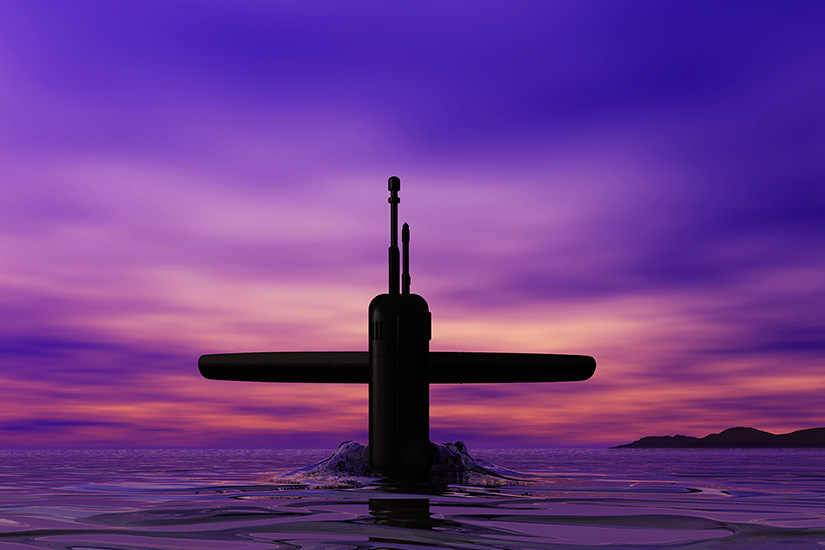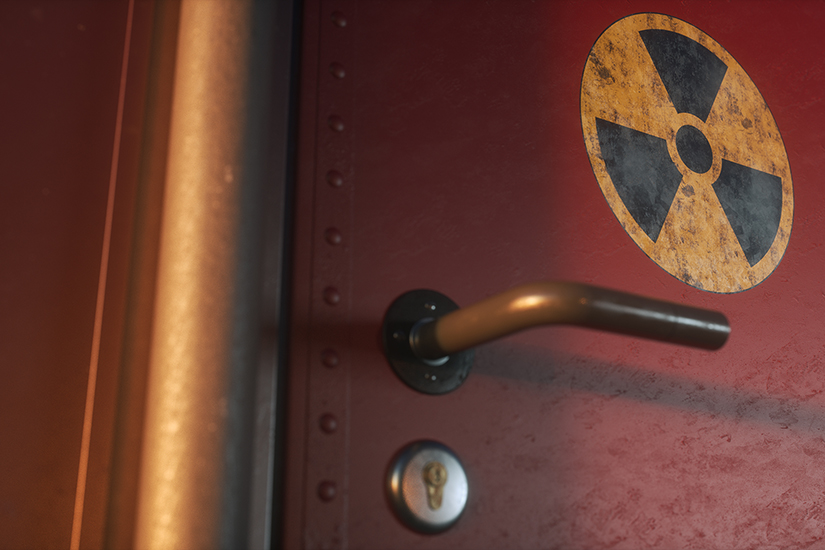1.The provision of nuclear submarine technology and concerns about proliferation
In September 2021, the leaders of Australia, the U.K., and the U.S. made news with the announcement of the AUKUS security framework. Although no specific countries were named as the target of the agreement, it is thought that the new arrangement is aimed at countering China’s growing influence in the Indo-Pacific region[1].
The agreement covers wide-ranging cooperation in fields like military matters, cyber, and artificial intelligence (AI), but it is the provision of nuclear submarine technology to Australia that has attracted international attention. Australia scrapped its agreement with France to develop conventional-powered submarines and will deploy eight nuclear submarines together with the U.K. and U.S. with a goal of monitoring the Chinese Navy. Based on this, the agreement must be considered as one that is deeply related to Japan’s security and may impact the international nuclear non-proliferation regime.
From the time they are commissioned until they are decommissioned, nuclear submarines do not need to be refueled. That means they can dive for extended periods, and they can be equipped with high-speed, long-range ballistic missiles. The submarines are powered by weapons-grade enriched uranium fuel, so New Zealand and other nearby countries, as well as China and Russia, have opposed the AUKUS agreement on the grounds that it would adversely affect the Treaty on the Non-Proliferation of Nuclear Weapons (NPT) through the transfer of nuclear material that could easily be converted into nuclear weapons to a non-nuclear state[2]. So far, only the five countries authorized by the NPT to possess nuclear weapons (China, France, Russia, the U.K., and the U.S.) and India, a non-signatory to the NPT that maintains nuclear weapons, have deployed nuclear submarines. If the plan to provide the vessels to Australia moves forward, it will become the first non-nuclear state to possess nuclear submarines.
This paper will analyze the objective of providing Australia with nuclear submarines and consider the issues it poses under the NPT and other international treaties. Finally, it will examine how Japan should respond to the provision of nuclear submarines to AUKUS and Australia.

2.The objective of providing nuclear submarines and the international reaction
In recent years, China stepped up its maritime expansion and it is believed to be deploying submarines equipped with nuclear-capable submarine-launched ballistic missiles (SLBMs) in the South China Sea, where the deep waters make submarine detection difficult. Moreover, the Chinese Navy, including its nuclear submarines, has been vigorously moving into the Central Pacific. It is thought that Australia determined that it could not match the Chinese Navy’s moves with conventional submarine and decided to acquire nuclear submarine technology from the U.K. and the U.S.[3]
Australia has emphasized that it will continue to comply with the provisions of the NPT and the International Atomic Energy Agency (IAEA), that it has no intention of possessing nuclear weapons, and that it will not equip nuclear submarines with nuclear weapons[4]. The U.S. and the U.K. have also pledged to cooperate with the IAEA regarding AUKUS and to fully comply with their non-proliferation obligations set forth in the NPT.
However, in October 2021, China sent a letter to the IAEA complaining that the safeguards that allow the agency to inspect the location and quantity of stored nuclear material cannot be effectively applied to the uranium fuel in nuclear submarines. Russia also voiced concerns about the nuclear submarine program and nonproliferation and called for the program to be stopped[5]. In addition, New Zealand has announced that it will not allow Australian submarines to enter its territorial waters[6].
As long as the three AUKUS countries and China, Russia, and New Zealand hold to different positions, it is necessary to consider the problems Australia’s deployment of nuclear submarines poses under the NPT and other international treaties.

3.International treaty issues and nonproliferation implications of nuclear submarine deployment
1) International treaties on the use of nuclear materials
Article 4 of the NPT states that the peaceful use of nuclear material by non-nuclear states is an “inalienable right,” while Article 3 stipulates that non-nuclear weapons states accept IAEA safeguards to prevent the diversion of nuclear energy to nuclear weapons and other nuclear explosive devices. Based on this, member states will individually conclude agreements with the IAEA on safeguards according to the circumstances of their use of nuclear energy.
Australia is one of the world's largest producers of natural uranium[7], but its domestic laws prohibit the commercial use of nuclear power, and it has only small-scale research reactors[8]. However, Australia has agreed to comprehensive safeguards that allow the IAEA to monitor nuclear fuel for research reactors and it is a party to the Additional Protocol[9] that allows the IAEA to conduct more stringent inspections, including unannounced visits.
However, Article 3 of the NPT and its safeguards do not totally prohibit the military use of nuclear material, and the inspections of such material can be suspended during the period they are used for military purposes if the relevant state adheres to IAEA controls preventing the materials from being diverted to nuclear weapons and it enters into a new agreement with the IAEA.
The fuel for Australia’s nuclear submarines will be provided by the U.S. or the U.K. when they are commissioned, and when they are decommissioned after 30 years of operation, the submarines will be returned to the U.S. or the U.K. along with their reactors and uranium fuel. Using this setup, Australia would not manufacture fuel and would not need to refuel its reactors, so it would not be difficult to prove to the IAEA that it would not remove fuel or divert it to nuclear weapons. However, the actual supply of nuclear submarines to Australia is not expected until the early 2040s at the earliest,[10] and it is not clear at this stage what form the supply of fuel to the submarines will take or what new safeguard arrangements will be required between the IAEA and Australia.
2) Implications for nonproliferation
Both China and Russia are concerned that the provision allowing for the temporary suspension of safeguards may become a loophole for the diversion of nuclear materials to nuclear weapons[11]. If other countries also ask the IAEA to temporarily suspend its safeguards and follow suit in deploying nuclear submarines, nuclear material that can be converted into nuclear weapons will proliferate.
Even if only Australia, an “honors student” when it comes to nonproliferation, takes this course of action, the impact will likely be significant. It has been very cooperative with IAEA safeguards, including being one of the first to sign the Additional Protocol, and at the NPT Review Conference[12] it formed the Non-Proliferation and Disarmament Initiative (NPDI) together with Japan. Moreover, it has served as a bridge between nuclear-armed states and non-aligned countries that seek nuclear abolition[13]. If Australia is seen to be taking advantage of the temporary suspension of safeguards as a loophole, it could set a bad precedent for South Korea, Iran, Brazil, and other counties seeking to acquire nuclear submarines.

4.AUKUS and Japan’s position
The Japanese response to the Australian introduction of nuclear submarines is not straightforward. The development must be viewed while considering both national security and the maintenance and strengthening of the international nonproliferation regime.
First, Japan is directly affected by China’s move to strengthen its effective control over the South China Sea and increase its influence in the Indo-Pacific region. To this end, Japan has strengthened its cooperation with the U.S. under the bilateral Security Treaty, and with Australia within the framework of the Quadrilateral Security Dialogue (Quad) and through the Australia-Japan Mutual Provision of Goods and Services Agreement and the Australia-Japan Foreign and Defence Ministerial Consultations. Japan should welcome the fact that the provision of nuclear submarines through AUKUS will have a deterrent effect on China.
However, Japan has historically pushed for nuclear nonproliferation as the only country to have experienced an atomic attack, and it should urge Australia to address concerns about nuclear proliferation by China, Russia, and other neighboring countries so that its nuclear submarines do not become a loophole in nonproliferation safeguards. Furthermore, as there is still a considerable amount of time before the vessels are actually deployed, it may become necessary to halt the deployment plan depending on changes in the international security environment.
(2022/3/28)
Notes
- 1 Tsuyoshi Nagasawa and Tsukasa Hadano, “U.S.-China rivalry flares undersea with Australia submarine deal,” Nikkei Asia, September 17, 2021.
- 2 Fumi Matsumoto and Koya Jibiki, “AUKUS sub deal triggers debate on nuclear safeguards,” Nikkei Asia, December 1, 2021.
- 3 Masakatsu Ota, “Creation of AUKUS a blow to nuclear nonproliferation regime,” Nagasaki Shimbun, October 2, 2021. (Japanese)
- 4 “U.S., U.K., Australia establish new security framework, China expresses concern,” NHK News, September 16, 2021.
- 5 “Australia’s nuclear submarine plan casts shadow over nonproliferation,” Nihon Keizai Shimbun, December 1, 2021. (Japanese)
- 6 Satoru Shoji, “Can the AUKUS framework be reconciled with the NPT?” Reuters, November 8, 2021 (reproduced from Jitsugyo no Nihonsha, “Jitsugyo no Nihon fooramu”).(Japanese)
- 7 According to the Japan Atomic Industrial Forum, Australia's proven and probable natural uranium resources for 2019 are the largest in the world at approximately 2,050,000 tU (tonnes of uranium, a unit of measurement in which uranium is converted to its metal form), accounting for a quarter of the global total. It is the third largest producer after Kazakhstan and Canada, with an output of about 6,500 tU.(Japanese)
- 8 Federation of Electric Power Companies, “Information on Overseas Power-related Topics [Australia] Majority of People Support Use of Nuclear Power to Reduce CO2 Emissions,” November 25, 2019.(Japanese)
- 9 Adopted by the IAEA Board of Governors in May 1997. In 1993, suspicions about Iraq and North Korea's nuclear programs led to considerations about strengthening the IAEA safeguards system. The IAEA’s authority was strengthened, including the addition of unannounced inspections, to ensure that there were no undeclared nuclear materials or facilities, and that nuclear materials under safeguards were not diverted for military use. As of April 2021, 137 countries, including Japan, are parties to the Additional Protocol. Ministry of Foreign Affairs, “IAEA Safeguards (2),” June 11, 2021.(Japanese)
- 10 John Carlson, “AUKUS Nuclear-Powered Submarine Deal – Non-proliferation Aspects,” Asia-Pacific Leadership Network (APLN), Series of APLN Analyses, September 17, 2021.
- 11 Ibid.
- 12 In addition to preventing an increase in the number of nuclear-armed states, the NPT obliges the states with nuclear weapons to negotiate in good faith for nuclear disarmament. Beacuse the results need to be reviewed periodically, an operational review meeting is held every five years. The 10th NPT Review Conference was scheduled to be held in April/May 2020, but it has been repeatedly postponed because of COVID-19. “Treaty on the Non-Proliferation of Nuclear Weapons (NPT) Review Conference,” Japanese Delegation to the Conference on Disarmament, "Treaty on the Non-Proliferation of Nuclear Weapons (NPT)," September 30, 2021. (Japanese)
- 13 Mitsuru Kurosawa, 50 Years of the Nuclear Non-Proliferation Treaty and Progress in Nuclear Disarmament, Shinzansha Publisher Co., April 2021, pp. 373-374.

